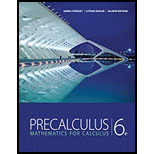
Concept explainers
To calculate:Thesimplified form of the expression
Answer to Problem 39E
The simplified form of the expression is
Explanation of Solution
Given information:
The expression is
Formula used:
To add or subtract rational expression, first find the common denominator and then use the following property of fractions:
If denominators are not same the find least common denominator. The least common denominator is found factoring each denominator and taking the product of distinct factors, using the highest power that appears in any of the factors.
Calculation:
Consider the provided expression.
Recall that,
To add or subtract rational expression, first find the common denominator and then use the following property of fractions:
If denominators are not same then find least common denominator. The least common denominator is found factoring each denominator and taking the product of distinct factors, using the highest power that appears in any of the factors.
Re-write the given expression as:
Since denominators are not the same then find the least common denominator,
The least common denominator of
Add fractions,
Combine terms in numerator,
Factor out
Thus, the simplified form of the expression is
Chapter 1 Solutions
EBK PRECALCULUS: MATHEMATICS FOR CALCUL
 Calculus: Early TranscendentalsCalculusISBN:9781285741550Author:James StewartPublisher:Cengage Learning
Calculus: Early TranscendentalsCalculusISBN:9781285741550Author:James StewartPublisher:Cengage Learning Thomas' Calculus (14th Edition)CalculusISBN:9780134438986Author:Joel R. Hass, Christopher E. Heil, Maurice D. WeirPublisher:PEARSON
Thomas' Calculus (14th Edition)CalculusISBN:9780134438986Author:Joel R. Hass, Christopher E. Heil, Maurice D. WeirPublisher:PEARSON Calculus: Early Transcendentals (3rd Edition)CalculusISBN:9780134763644Author:William L. Briggs, Lyle Cochran, Bernard Gillett, Eric SchulzPublisher:PEARSON
Calculus: Early Transcendentals (3rd Edition)CalculusISBN:9780134763644Author:William L. Briggs, Lyle Cochran, Bernard Gillett, Eric SchulzPublisher:PEARSON Calculus: Early TranscendentalsCalculusISBN:9781319050740Author:Jon Rogawski, Colin Adams, Robert FranzosaPublisher:W. H. Freeman
Calculus: Early TranscendentalsCalculusISBN:9781319050740Author:Jon Rogawski, Colin Adams, Robert FranzosaPublisher:W. H. Freeman
 Calculus: Early Transcendental FunctionsCalculusISBN:9781337552516Author:Ron Larson, Bruce H. EdwardsPublisher:Cengage Learning
Calculus: Early Transcendental FunctionsCalculusISBN:9781337552516Author:Ron Larson, Bruce H. EdwardsPublisher:Cengage Learning





